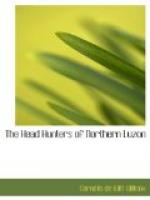were so soft and friable that they could be gouged
out with ease with the hand, and appeared to be vegetable,
while the white stripes were most probably limestone.
This bit of the trail is regarded as dangerous, because
the rock overhead is continually breaking loose and
tumbling down; for this reason it was unsafe to try
to dislodge pieces for later examination. One
of our
cargadores, as it was, fell over, his
pack getting knocked in, while he himself escaped
with a bruise or two. It was a bad place!
At the end of it a host of Kalingas acclaimed us,
as picturesque as the warriors we had met at the stream,
and took over the pack. Leaving the river, we
began what appeared to be an interminable climb to
Lubuagan. Up ran the trail, disappearing far
ahead above us, behind the shoulder of the ridge;
and we would all be hoping (those of us to whom the
country was new) that Lubuagan would be just around
the turn, only to find we had the same sort of climb
to another shoulder; the fact being that the ridge
here thrust itself out in rising echeloned spurs, each
one of which had to be turned, so that we began to
doubt if there was such a place as the capital of
the Kalinga province. In truth, we had been up
since 3:30 and were nearly spent from heat and thirst.
But at last we made the final turn, and entered upon
a narrow green valley, with a bold, clear stream rushing
over and between the rocks that filled its bed.
Broad-leafed plants nodded a welcome from the waters,
as we rode through the grateful shadow of the overarching
trees, and shining pools smiled upon us. We crossed
a bridge, came down a bit, and, breaking through the
fringe of trees and shrubs, saw before us the place-of-arms
of Lubuagan.
CHAPTER XXII
Splendid appearance of the
Kalingas.—Dancing.—Lubuagan.—Basi.
—Councils.—Bustles
and braids.—Jewels and weapons.—Excellent
houses.
The sight that greeted us was stirring, suggesting
to the piously minded Bishop Heber’s unmatched
lines:
“A noble army, men and
boys,
The
matron and the maid.”
There must have been thousands of people, as many
women as men, and almost as many children as women,
all of whom set up a mighty shout as our little column
emerged. But what especially and immediately
caught the eye was the brilliancy of the scene.
For, whereas the people so far encountered had impressed
us by the sobriety of color displayed, these Kalingas
blazed out upon us in the most vivid reds and yellows.
Many of them, women as well as men, had on tight-fitting
Moro jackets of red and yellow stripes; but whatever
it was—skirt, jacket, or gee-string—only
one pattern showed itself, the alternation of red
and yellow, well brought out by the clear brown of
the skin. As though this were not enough, some
men had adorned their abundant black hair with scarlet
hibiscus flowers, and all, or nearly all, wore plumes




